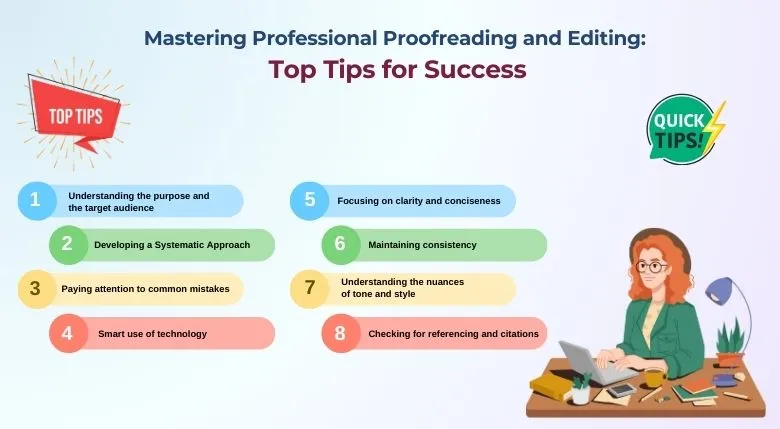 In the realm of professional writing, clear and accurate communication holds immense value. Be it writing for academic papers, business documents, or creative content; proofreading and editing are essential steps in ensuring that the final document is free of errors and impactful. Businesses these days are opting for website content proofreading services in lieu of meeting the expectations and preferences of the target demographic.In this web blog, we will explore some essential tips that can come in handy for companies offering professional proofreading services for businesses ensuring that proofreaders and editors can deliver their highest quality work as per the client’s needs.
In the realm of professional writing, clear and accurate communication holds immense value. Be it writing for academic papers, business documents, or creative content; proofreading and editing are essential steps in ensuring that the final document is free of errors and impactful. Businesses these days are opting for website content proofreading services in lieu of meeting the expectations and preferences of the target demographic.In this web blog, we will explore some essential tips that can come in handy for companies offering professional proofreading services for businesses ensuring that proofreaders and editors can deliver their highest quality work as per the client’s needs.
Understanding the Purpose and the Target Audience
Before going ahead with the process of editing, it is important to understand the purpose of the document and for whom that document is intended. Whether it is an academic paper, a marketing document, or a business proposal; each type of document will have its own style and tone. Understanding these nuances is essential for effective editing. For instance, business writing editing and proofreading would require formal language and adherence to a specific style, while the marketing content would need a more conversational tone. It might pique your interest to explore languages in which one should translate their marketing campaigns. If you want to learn more, you can read this informational web blog on Languages in Which You Must Translate Your Marketing Campaigns.
Developing a Systematic Approach
The process of reviewing needs a methodological and systematic approach to be able to identify every potential error. Developing strategies like breaking down the process into multiple stages and then focusing on the important aspects like grammar, punctuation, and spelling in the subsequent rounds; followed by reviewing it for consistency in style and tone can reduce the risk of overlooking errors and ensure a foolproof edit.
Paying Attention to Common Mistakes
Certain mistakes tend to occur commonly in English writing. This could be issues like subject-verb agreements, incorrect use of homophones (their/there/they’re), and misplaced modifiers. Being aware of these common errors and rectifying them efficiently can help render a polished document. It might pique your interest to explore some essential tips for English translations if you want to learn more you can read this engaging piece on The Art of English Translations: Key Tips for Success.
Do you want to elevate your editing skills?
Discover top tips for mastering professional proofreading and editing! Start perfecting your craft today.
Smart Use of Technology
While tools like spelling checkers and grammar software like Grammarly or Hemingway can be greatly helpful, they are not completely reliable. Such tools often tend to miss the contextual errors and stylistic issues that require the assistance of human experts. For example, the words compliment and complement sound similar but differ in meaning. An automated spell check tool may be able to correct inaccuracies in the spelling but won’t be able to rectify this contextual mistake.
Focusing on Clarity and Conciseness
A piece of good writing is supposed to be clear and concise. When the document is being reviewed, the editors must look for opportunities to simplify complex elements like sentences and eliminate unnecessary words. Using conjunctions and crisp content will not only improve the readability of the document but will also make it more engaging for the reader.
Maintaining Consistency
Any professional and polished document has the element of consistency. Consistency here includes uniformity in spelling, capitalization, punctuation, and formatting. For instance, if the client has a specific style book/guide, then the editor should meticulously adhere to it. If he is using the Oxford comma, then he must ensure that it is present throughout the document. Using style guides like the Chicago Manual of Style or the AP Stylebook can be important resources for enhancing consistency in the project.
Understanding the Nuances of Tone and Style
Different types of documents have different types of tones and styles; as a professional proofreader, it is essential to adapt the content accordingly. For instance, a legal paper will require a formal and precise tone, whereas a blog post will have a more casual and conversational style of writing. Understanding and following these nuances can preserve the author’s voice while enhancing the overall readability of the document.
Checking for Referencing and Citations
In professional and academic writing, accurate referencing and citations are very important. Ensuring that all the sources are accurately cited according to the required style (e.g., APA, MLA, and Chicago) is necessary. This involves checking that the in-text citations match the bibliography and that all important information is mentioned. Inaccurate or incomplete citations can affect the credibility of the document and lead to issues like plagiarism.
Do you want to elevate your editing skills?
Discover top tips for mastering professional proofreading and editing! Start perfecting your craft today.
Corollary Words
Professional English proofreading and editing solutions require a combination of expertise in language, attention to detail, and a clear understanding of the purpose of the document and the target audience. By following the above-mentioned tips, one can ensure that they deliver polished and good-quality work that matches the expectations of the client. Efficient proofreading and editing service providers like Somya Translators provide one of the best Chinese proofreading services at the most affordable rates. You may get in touch now to avail yourself a free quote!







